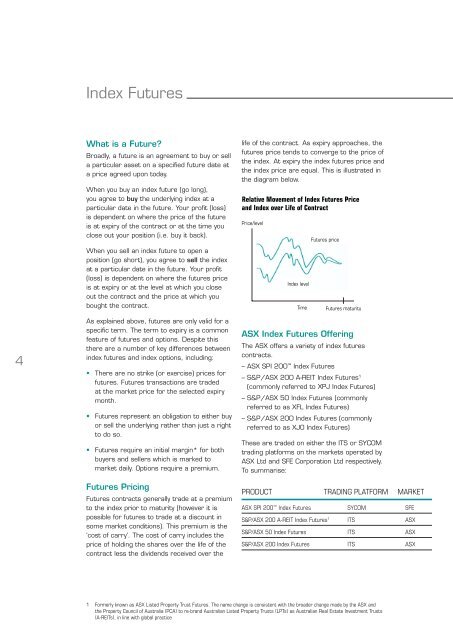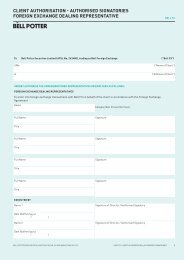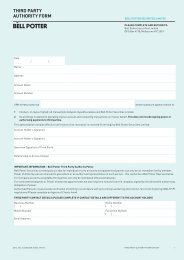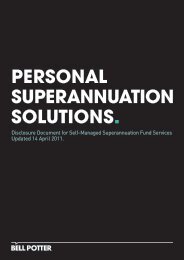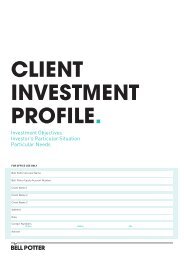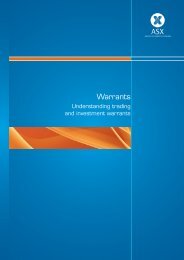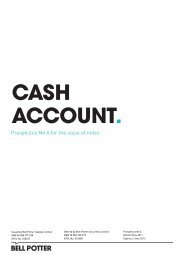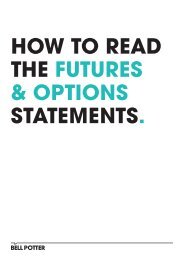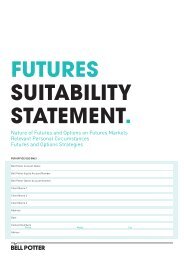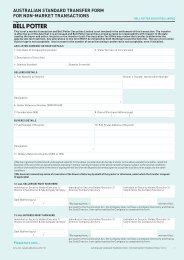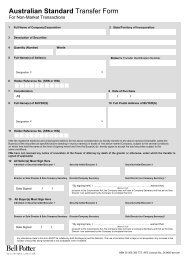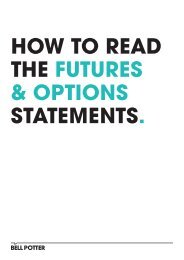Introduction to Index Futures and Options - Bell Potter Securities
Introduction to Index Futures and Options - Bell Potter Securities
Introduction to Index Futures and Options - Bell Potter Securities
Create successful ePaper yourself
Turn your PDF publications into a flip-book with our unique Google optimized e-Paper software.
<strong>Index</strong> <strong>Futures</strong><br />
4<br />
What is a Future<br />
Broadly, a future is an agreement <strong>to</strong> buy or sell<br />
a particular asset on a specified future date at<br />
a price agreed upon <strong>to</strong>day.<br />
When you buy an index future (go long),<br />
you agree <strong>to</strong> buy the underlying index at a<br />
particular date in the future. Your profit (loss)<br />
is dependent on where the price of the future<br />
is at expiry of the contract or at the time you<br />
close out your position (i.e. buy it back).<br />
When you sell an index future <strong>to</strong> open a<br />
position (go short), you agree <strong>to</strong> sell the index<br />
at a particular date in the future. Your profit<br />
(loss) is dependent on where the futures price<br />
is at expiry or at the level at which you close<br />
out the contract <strong>and</strong> the price at which you<br />
bought the contract.<br />
As explained above, futures are only valid for a<br />
specific term. The term <strong>to</strong> expiry is a common<br />
feature of futures <strong>and</strong> options. Despite this<br />
there are a number of key differences between<br />
index futures <strong>and</strong> index options, including:<br />
• There are no strike (or exercise) prices for<br />
futures. <strong>Futures</strong> transactions are traded<br />
at the market price for the selected expiry<br />
month.<br />
• <strong>Futures</strong> represent an obligation <strong>to</strong> either buy<br />
or sell the underlying rather than just a right<br />
<strong>to</strong> do so.<br />
• <strong>Futures</strong> require an initial margin* for both<br />
buyers <strong>and</strong> sellers which is marked <strong>to</strong><br />
market daily. <strong>Options</strong> require a premium.<br />
<strong>Futures</strong> Pricing<br />
<strong>Futures</strong> contracts generally trade at a premium<br />
<strong>to</strong> the index prior <strong>to</strong> maturity (however it is<br />
possible for futures <strong>to</strong> trade at a discount in<br />
some market conditions). This premium is the<br />
‘cost of carry’. The cost of carry includes the<br />
price of holding the shares over the life of the<br />
contract less the dividends received over the<br />
life of the contract. As expiry approaches, the<br />
futures price tends <strong>to</strong> converge <strong>to</strong> the price of<br />
the index. At expiry the index futures price <strong>and</strong><br />
the index price are equal. This is illustrated in<br />
the diagram below.<br />
Relative Movement of <strong>Index</strong> <strong>Futures</strong> Price<br />
<strong>and</strong> <strong>Index</strong> over Life of Contract<br />
Price/level<br />
<strong>Index</strong> level<br />
Time<br />
<strong>Futures</strong> price<br />
ASX <strong>Index</strong> <strong>Futures</strong> Offering<br />
The ASX offers a variety of index futures<br />
contracts.<br />
– ASX SPI 200 <strong>Index</strong> <strong>Futures</strong><br />
<strong>Futures</strong> maturity<br />
– S&P/ASX 200 A-REIT <strong>Index</strong> <strong>Futures</strong> 1<br />
(commonly referred <strong>to</strong> XPJ <strong>Index</strong> <strong>Futures</strong>)<br />
– S&P/ASX 50 <strong>Index</strong> <strong>Futures</strong> (commonly<br />
referred <strong>to</strong> as XFL <strong>Index</strong> <strong>Futures</strong>)<br />
– S&P/ASX 200 <strong>Index</strong> <strong>Futures</strong> (commonly<br />
referred <strong>to</strong> as XJO <strong>Index</strong> <strong>Futures</strong>)<br />
These are traded on either the ITS or SYCOM<br />
trading platforms on the markets operated by<br />
ASX Ltd <strong>and</strong> SFE Corporation Ltd respectively.<br />
To summarise:<br />
Product Trading Platform market<br />
ASX SPI 200 <strong>Index</strong> <strong>Futures</strong> SYCOM SFE<br />
S&P/ASX 200 A-REIT <strong>Index</strong> <strong>Futures</strong> 1 ITS ASX<br />
S&P/ASX 50 <strong>Index</strong> <strong>Futures</strong> ITS ASX<br />
S&P/ASX 200 <strong>Index</strong> <strong>Futures</strong> ITS ASX<br />
1 Formerly known as ASX Listed Property Trust <strong>Futures</strong>. The name change is consistent with the broader change made by the ASX <strong>and</strong><br />
the Property Council of Australia (PCA) <strong>to</strong> re-br<strong>and</strong> Australian Listed Property Trusts (LPTs) as Australian Real Estate Investment Trusts<br />
(A-REITs), in line with global practice


